- 工作流具有预设的代码路径,并按特定顺序运行。
- 代理是动态的,它们定义自己的流程和工具使用方式。
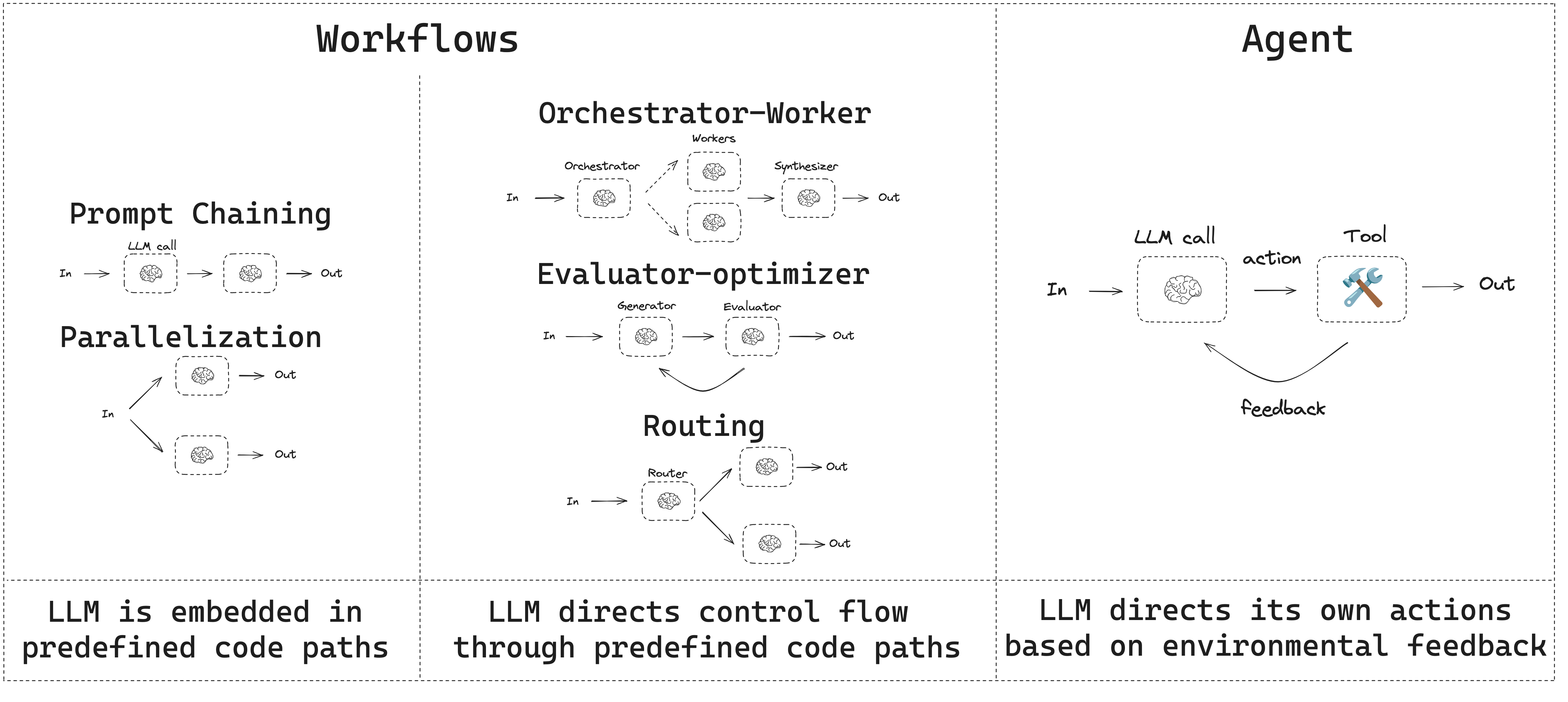
设置
要构建工作流或代理,您可以使用任何支持结构化输出和工具调用的聊天模型。以下示例使用 Anthropic。- 安装依赖项
复制
向 AI 提问
pip install langchain_core langchain-anthropic langgraph
- 初始化LLM
复制
向 AI 提问
import os
import getpass
from langchain_anthropic import ChatAnthropic
def _set_env(var: str):
if not os.environ.get(var):
os.environ[var] = getpass.getpass(f"{var}: ")
_set_env("ANTHROPIC_API_KEY")
llm = ChatAnthropic(model="claude-sonnet-4-5-20250929")
大型语言模型(LLM)与增强功能
工作流和代理系统基于大型语言模型(LLM)以及您为其添加的各种增强功能。工具调用、结构化输出和短期记忆是根据您的需求定制LLM的几种选项。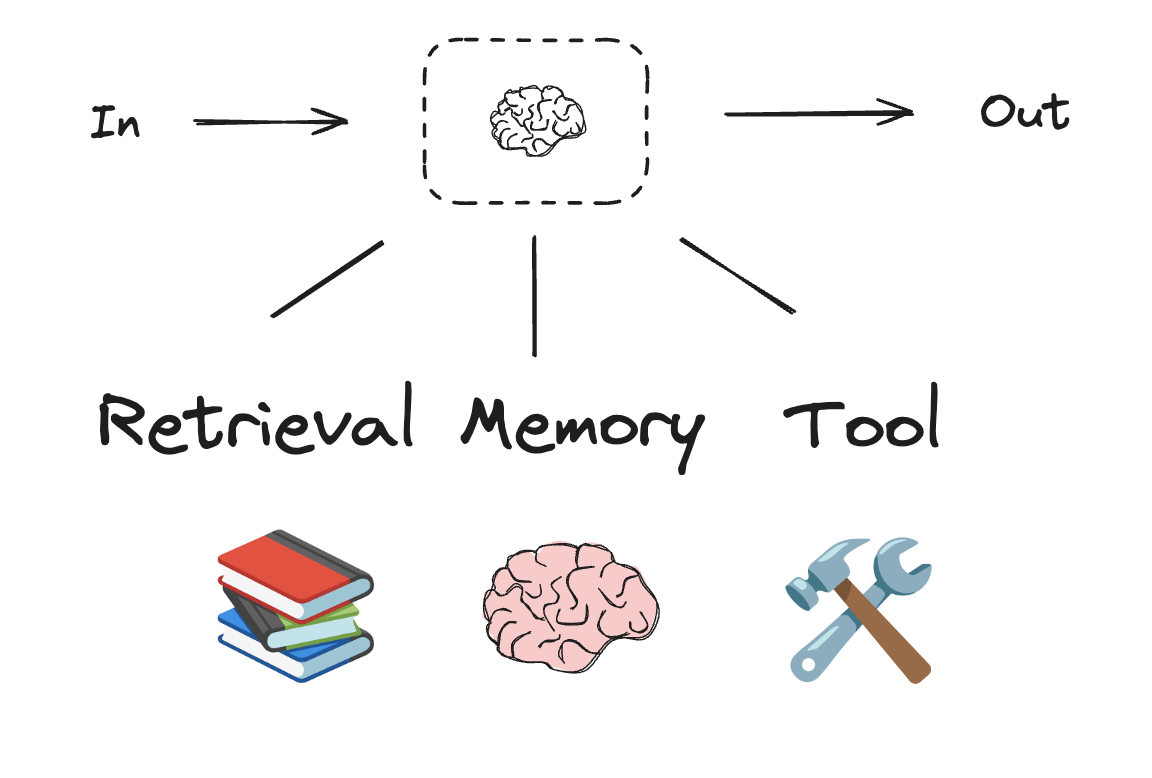
复制
向 AI 提问
# Schema for structured output
from pydantic import BaseModel, Field
class SearchQuery(BaseModel):
search_query: str = Field(None, description="Query that is optimized web search.")
justification: str = Field(
None, description="Why this query is relevant to the user's request."
)
# Augment the LLM with schema for structured output
structured_llm = llm.with_structured_output(SearchQuery)
# Invoke the augmented LLM
output = structured_llm.invoke("How does Calcium CT score relate to high cholesterol?")
# Define a tool
def multiply(a: int, b: int) -> int:
return a * b
# Augment the LLM with tools
llm_with_tools = llm.bind_tools([multiply])
# Invoke the LLM with input that triggers the tool call
msg = llm_with_tools.invoke("What is 2 times 3?")
# Get the tool call
msg.tool_calls
提示链
提示链是指每次LLM调用都处理前一次调用的输出。它通常用于执行可以分解为更小、可验证步骤的明确任务。一些例子包括:- 将文档翻译成不同的语言
- 验证生成内容的一致性

复制
向 AI 提问
from typing_extensions import TypedDict
from langgraph.graph import StateGraph, START, END
from IPython.display import Image, display
# Graph state
class State(TypedDict):
topic: str
joke: str
improved_joke: str
final_joke: str
# Nodes
def generate_joke(state: State):
"""First LLM call to generate initial joke"""
msg = llm.invoke(f"Write a short joke about {state['topic']}")
return {"joke": msg.content}
def check_punchline(state: State):
"""Gate function to check if the joke has a punchline"""
# Simple check - does the joke contain "?" or "!"
if "?" in state["joke"] or "!" in state["joke"]:
return "Pass"
return "Fail"
def improve_joke(state: State):
"""Second LLM call to improve the joke"""
msg = llm.invoke(f"Make this joke funnier by adding wordplay: {state['joke']}")
return {"improved_joke": msg.content}
def polish_joke(state: State):
"""Third LLM call for final polish"""
msg = llm.invoke(f"Add a surprising twist to this joke: {state['improved_joke']}")
return {"final_joke": msg.content}
# Build workflow
workflow = StateGraph(State)
# Add nodes
workflow.add_node("generate_joke", generate_joke)
workflow.add_node("improve_joke", improve_joke)
workflow.add_node("polish_joke", polish_joke)
# Add edges to connect nodes
workflow.add_edge(START, "generate_joke")
workflow.add_conditional_edges(
"generate_joke", check_punchline, {"Fail": "improve_joke", "Pass": END}
)
workflow.add_edge("improve_joke", "polish_joke")
workflow.add_edge("polish_joke", END)
# Compile
chain = workflow.compile()
# Show workflow
display(Image(chain.get_graph().draw_mermaid_png()))
# Invoke
state = chain.invoke({"topic": "cats"})
print("Initial joke:")
print(state["joke"])
print("\n--- --- ---\n")
if "improved_joke" in state:
print("Improved joke:")
print(state["improved_joke"])
print("\n--- --- ---\n")
print("Final joke:")
print(state["final_joke"])
else:
print("Joke failed quality gate - no punchline detected!")
并行化
通过并行化,LLM 同时执行任务。这可以通过同时运行多个独立的子任务来实现,也可以通过多次运行同一任务以检查不同的输出。并行化通常用于:- 分解子任务并并行运行,从而提高速度
- 多次运行任务以检查不同的输出,从而提高置信度
- 运行一个子任务处理文档中的关键词,另一个子任务检查格式错误
- 多次运行一个任务,根据不同标准(如引文数量、使用来源数量和来源质量)评估文档的准确性

复制
向 AI 提问
# Graph state
class State(TypedDict):
topic: str
joke: str
story: str
poem: str
combined_output: str
# Nodes
def call_llm_1(state: State):
"""First LLM call to generate initial joke"""
msg = llm.invoke(f"Write a joke about {state['topic']}")
return {"joke": msg.content}
def call_llm_2(state: State):
"""Second LLM call to generate story"""
msg = llm.invoke(f"Write a story about {state['topic']}")
return {"story": msg.content}
def call_llm_3(state: State):
"""Third LLM call to generate poem"""
msg = llm.invoke(f"Write a poem about {state['topic']}")
return {"poem": msg.content}
def aggregator(state: State):
"""Combine the joke and story into a single output"""
combined = f"Here's a story, joke, and poem about {state['topic']}!\n\n"
combined += f"STORY:\n{state['story']}\n\n"
combined += f"JOKE:\n{state['joke']}\n\n"
combined += f"POEM:\n{state['poem']}"
return {"combined_output": combined}
# Build workflow
parallel_builder = StateGraph(State)
# Add nodes
parallel_builder.add_node("call_llm_1", call_llm_1)
parallel_builder.add_node("call_llm_2", call_llm_2)
parallel_builder.add_node("call_llm_3", call_llm_3)
parallel_builder.add_node("aggregator", aggregator)
# Add edges to connect nodes
parallel_builder.add_edge(START, "call_llm_1")
parallel_builder.add_edge(START, "call_llm_2")
parallel_builder.add_edge(START, "call_llm_3")
parallel_builder.add_edge("call_llm_1", "aggregator")
parallel_builder.add_edge("call_llm_2", "aggregator")
parallel_builder.add_edge("call_llm_3", "aggregator")
parallel_builder.add_edge("aggregator", END)
parallel_workflow = parallel_builder.compile()
# Show workflow
display(Image(parallel_workflow.get_graph().draw_mermaid_png()))
# Invoke
state = parallel_workflow.invoke({"topic": "cats"})
print(state["combined_output"])
路由
路由工作流处理输入,然后将其定向到特定上下文的任务。这允许您为复杂任务定义专门的流程。例如,一个旨在回答产品相关问题的工作流可能会首先处理问题的类型,然后将请求路由到定价、退款、退货等特定流程。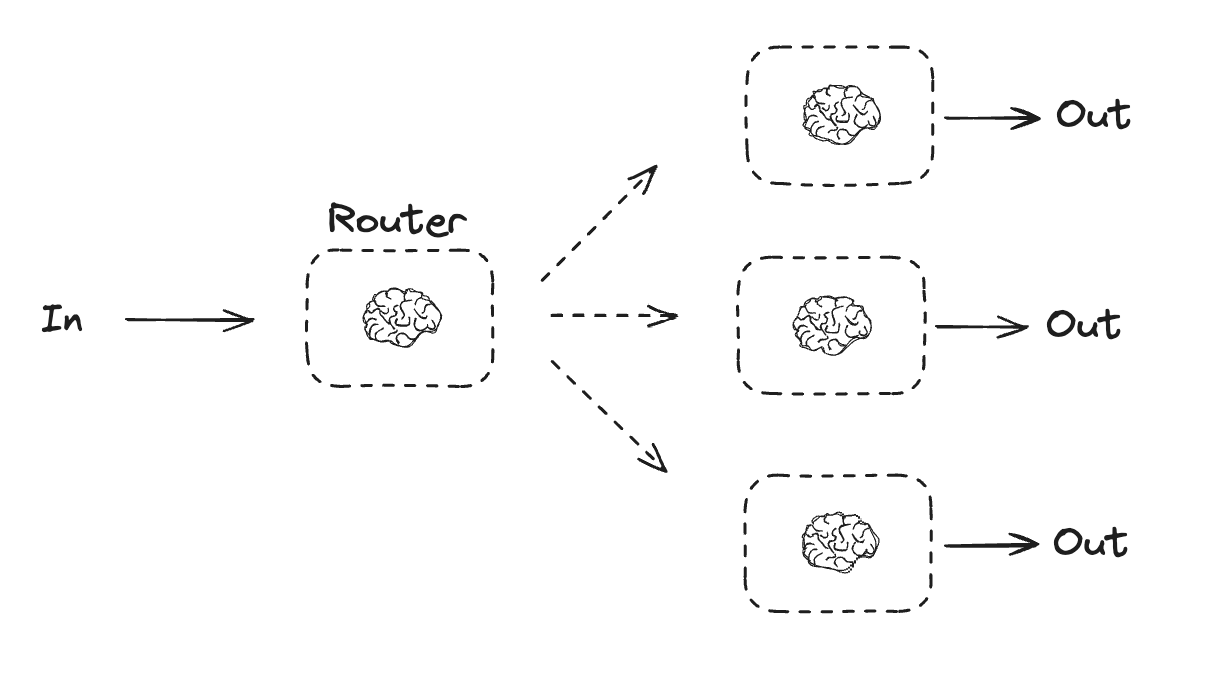
复制
向 AI 提问
from typing_extensions import Literal
from langchain.messages import HumanMessage, SystemMessage
# Schema for structured output to use as routing logic
class Route(BaseModel):
step: Literal["poem", "story", "joke"] = Field(
None, description="The next step in the routing process"
)
# Augment the LLM with schema for structured output
router = llm.with_structured_output(Route)
# State
class State(TypedDict):
input: str
decision: str
output: str
# Nodes
def llm_call_1(state: State):
"""Write a story"""
result = llm.invoke(state["input"])
return {"output": result.content}
def llm_call_2(state: State):
"""Write a joke"""
result = llm.invoke(state["input"])
return {"output": result.content}
def llm_call_3(state: State):
"""Write a poem"""
result = llm.invoke(state["input"])
return {"output": result.content}
def llm_call_router(state: State):
"""Route the input to the appropriate node"""
# Run the augmented LLM with structured output to serve as routing logic
decision = router.invoke(
[
SystemMessage(
content="Route the input to story, joke, or poem based on the user's request."
),
HumanMessage(content=state["input"]),
]
)
return {"decision": decision.step}
# Conditional edge function to route to the appropriate node
def route_decision(state: State):
# Return the node name you want to visit next
if state["decision"] == "story":
return "llm_call_1"
elif state["decision"] == "joke":
return "llm_call_2"
elif state["decision"] == "poem":
return "llm_call_3"
# Build workflow
router_builder = StateGraph(State)
# Add nodes
router_builder.add_node("llm_call_1", llm_call_1)
router_builder.add_node("llm_call_2", llm_call_2)
router_builder.add_node("llm_call_3", llm_call_3)
router_builder.add_node("llm_call_router", llm_call_router)
# Add edges to connect nodes
router_builder.add_edge(START, "llm_call_router")
router_builder.add_conditional_edges(
"llm_call_router",
route_decision,
{ # Name returned by route_decision : Name of next node to visit
"llm_call_1": "llm_call_1",
"llm_call_2": "llm_call_2",
"llm_call_3": "llm_call_3",
},
)
router_builder.add_edge("llm_call_1", END)
router_builder.add_edge("llm_call_2", END)
router_builder.add_edge("llm_call_3", END)
# Compile workflow
router_workflow = router_builder.compile()
# Show the workflow
display(Image(router_workflow.get_graph().draw_mermaid_png()))
# Invoke
state = router_workflow.invoke({"input": "Write me a joke about cats"})
print(state["output"])
协调器-工作者
在协调器-工作者配置中,协调器:- 将任务分解为子任务
- 将子任务委派给工作者
- 将工作者输出合成为最终结果
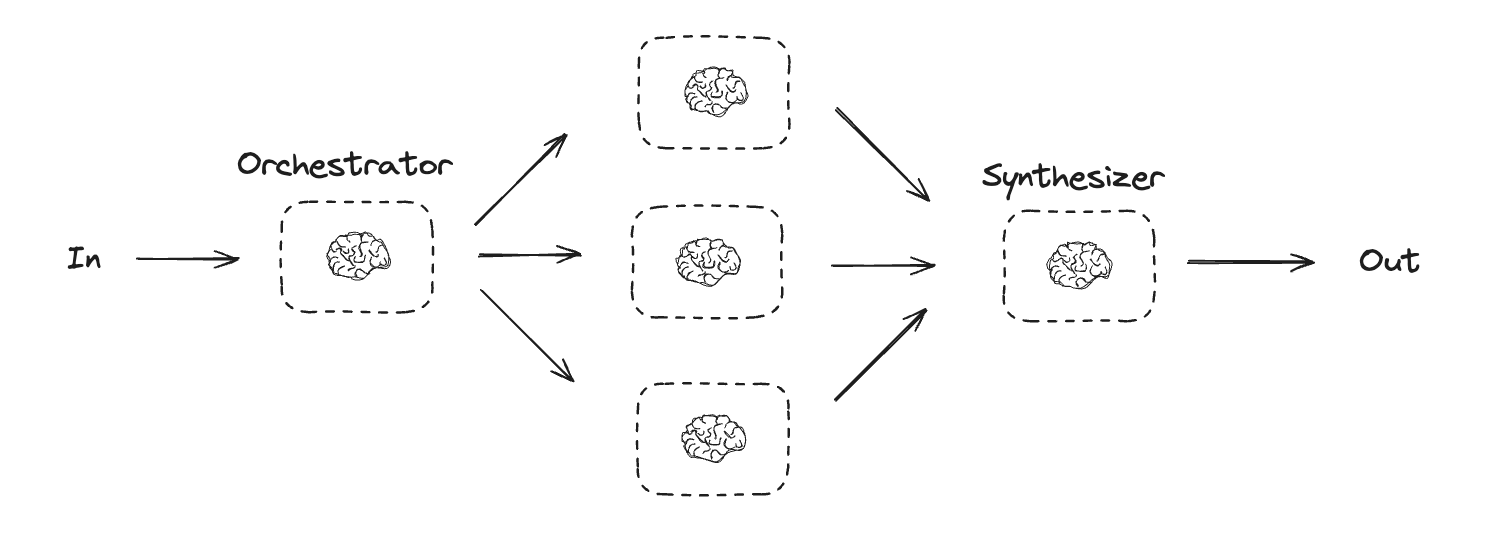
复制
向 AI 提问
from typing import Annotated, List
import operator
# Schema for structured output to use in planning
class Section(BaseModel):
name: str = Field(
description="Name for this section of the report.",
)
description: str = Field(
description="Brief overview of the main topics and concepts to be covered in this section.",
)
class Sections(BaseModel):
sections: List[Section] = Field(
description="Sections of the report.",
)
# Augment the LLM with schema for structured output
planner = llm.with_structured_output(Sections)
在LangGraph中创建工作者
协调器-工作者工作流很常见,LangGraph 对其提供了内置支持。`Send` API 允许您动态创建工作者节点并向其发送特定输入。每个工作者都有自己的状态,所有工作者输出都写入一个共享状态键,该键可供协调器图访问。这使得协调器可以访问所有工作者输出,并允许将其合成为最终输出。下面的示例遍历节列表,并使用 `Send` API 将每个节发送给一个工作者。复制
向 AI 提问
from langgraph.types import Send
# Graph state
class State(TypedDict):
topic: str # Report topic
sections: list[Section] # List of report sections
completed_sections: Annotated[
list, operator.add
] # All workers write to this key in parallel
final_report: str # Final report
# Worker state
class WorkerState(TypedDict):
section: Section
completed_sections: Annotated[list, operator.add]
# Nodes
def orchestrator(state: State):
"""Orchestrator that generates a plan for the report"""
# Generate queries
report_sections = planner.invoke(
[
SystemMessage(content="Generate a plan for the report."),
HumanMessage(content=f"Here is the report topic: {state['topic']}"),
]
)
return {"sections": report_sections.sections}
def llm_call(state: WorkerState):
"""Worker writes a section of the report"""
# Generate section
section = llm.invoke(
[
SystemMessage(
content="Write a report section following the provided name and description. Include no preamble for each section. Use markdown formatting."
),
HumanMessage(
content=f"Here is the section name: {state['section'].name} and description: {state['section'].description}"
),
]
)
# Write the updated section to completed sections
return {"completed_sections": [section.content]}
def synthesizer(state: State):
"""Synthesize full report from sections"""
# List of completed sections
completed_sections = state["completed_sections"]
# Format completed section to str to use as context for final sections
completed_report_sections = "\n\n---\n\n".join(completed_sections)
return {"final_report": completed_report_sections}
# Conditional edge function to create llm_call workers that each write a section of the report
def assign_workers(state: State):
"""Assign a worker to each section in the plan"""
# Kick off section writing in parallel via Send() API
return [Send("llm_call", {"section": s}) for s in state["sections"]]
# Build workflow
orchestrator_worker_builder = StateGraph(State)
# Add the nodes
orchestrator_worker_builder.add_node("orchestrator", orchestrator)
orchestrator_worker_builder.add_node("llm_call", llm_call)
orchestrator_worker_builder.add_node("synthesizer", synthesizer)
# Add edges to connect nodes
orchestrator_worker_builder.add_edge(START, "orchestrator")
orchestrator_worker_builder.add_conditional_edges(
"orchestrator", assign_workers, ["llm_call"]
)
orchestrator_worker_builder.add_edge("llm_call", "synthesizer")
orchestrator_worker_builder.add_edge("synthesizer", END)
# Compile the workflow
orchestrator_worker = orchestrator_worker_builder.compile()
# Show the workflow
display(Image(orchestrator_worker.get_graph().draw_mermaid_png()))
# Invoke
state = orchestrator_worker.invoke({"topic": "Create a report on LLM scaling laws"})
from IPython.display import Markdown
Markdown(state["final_report"])
评估器-优化器
在评估器-优化器工作流中,一次 LLM 调用创建响应,另一次调用评估该响应。如果评估器或人工介入确定响应需要改进,则会提供反馈并重新创建响应。这个循环一直持续到生成可接受的响应。 评估器-优化器工作流通常用于任务有特定成功标准,但需要迭代才能达到该标准的情况。例如,两种语言之间的文本翻译并不总能完美匹配。可能需要多次迭代才能生成在两种语言中含义相同的翻译。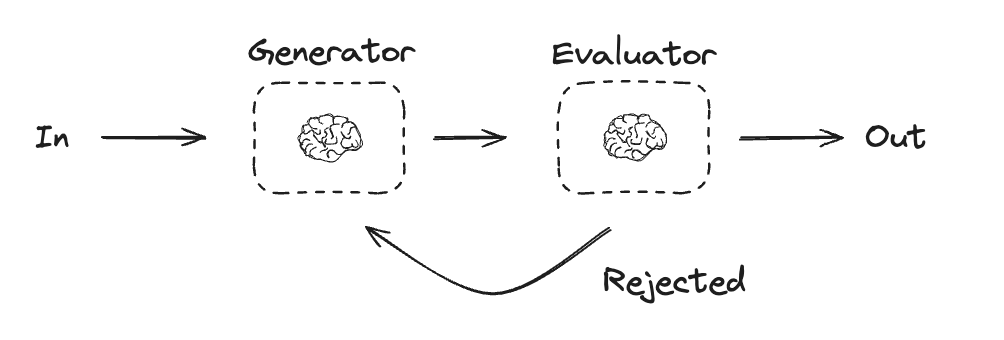
复制
向 AI 提问
# Graph state
class State(TypedDict):
joke: str
topic: str
feedback: str
funny_or_not: str
# Schema for structured output to use in evaluation
class Feedback(BaseModel):
grade: Literal["funny", "not funny"] = Field(
description="Decide if the joke is funny or not.",
)
feedback: str = Field(
description="If the joke is not funny, provide feedback on how to improve it.",
)
# Augment the LLM with schema for structured output
evaluator = llm.with_structured_output(Feedback)
# Nodes
def llm_call_generator(state: State):
"""LLM generates a joke"""
if state.get("feedback"):
msg = llm.invoke(
f"Write a joke about {state['topic']} but take into account the feedback: {state['feedback']}"
)
else:
msg = llm.invoke(f"Write a joke about {state['topic']}")
return {"joke": msg.content}
def llm_call_evaluator(state: State):
"""LLM evaluates the joke"""
grade = evaluator.invoke(f"Grade the joke {state['joke']}")
return {"funny_or_not": grade.grade, "feedback": grade.feedback}
# Conditional edge function to route back to joke generator or end based upon feedback from the evaluator
def route_joke(state: State):
"""Route back to joke generator or end based upon feedback from the evaluator"""
if state["funny_or_not"] == "funny":
return "Accepted"
elif state["funny_or_not"] == "not funny":
return "Rejected + Feedback"
# Build workflow
optimizer_builder = StateGraph(State)
# Add the nodes
optimizer_builder.add_node("llm_call_generator", llm_call_generator)
optimizer_builder.add_node("llm_call_evaluator", llm_call_evaluator)
# Add edges to connect nodes
optimizer_builder.add_edge(START, "llm_call_generator")
optimizer_builder.add_edge("llm_call_generator", "llm_call_evaluator")
optimizer_builder.add_conditional_edges(
"llm_call_evaluator",
route_joke,
{ # Name returned by route_joke : Name of next node to visit
"Accepted": END,
"Rejected + Feedback": "llm_call_generator",
},
)
# Compile the workflow
optimizer_workflow = optimizer_builder.compile()
# Show the workflow
display(Image(optimizer_workflow.get_graph().draw_mermaid_png()))
# Invoke
state = optimizer_workflow.invoke({"topic": "Cats"})
print(state["joke"])
代理
代理通常被实现为使用工具执行操作的LLM。它们在连续的反馈循环中运行,并用于问题和解决方案不可预测的情况。代理比工作流拥有更多的自主权,可以决定使用哪些工具以及如何解决问题。您仍然可以定义可用的工具集和代理行为的指导方针。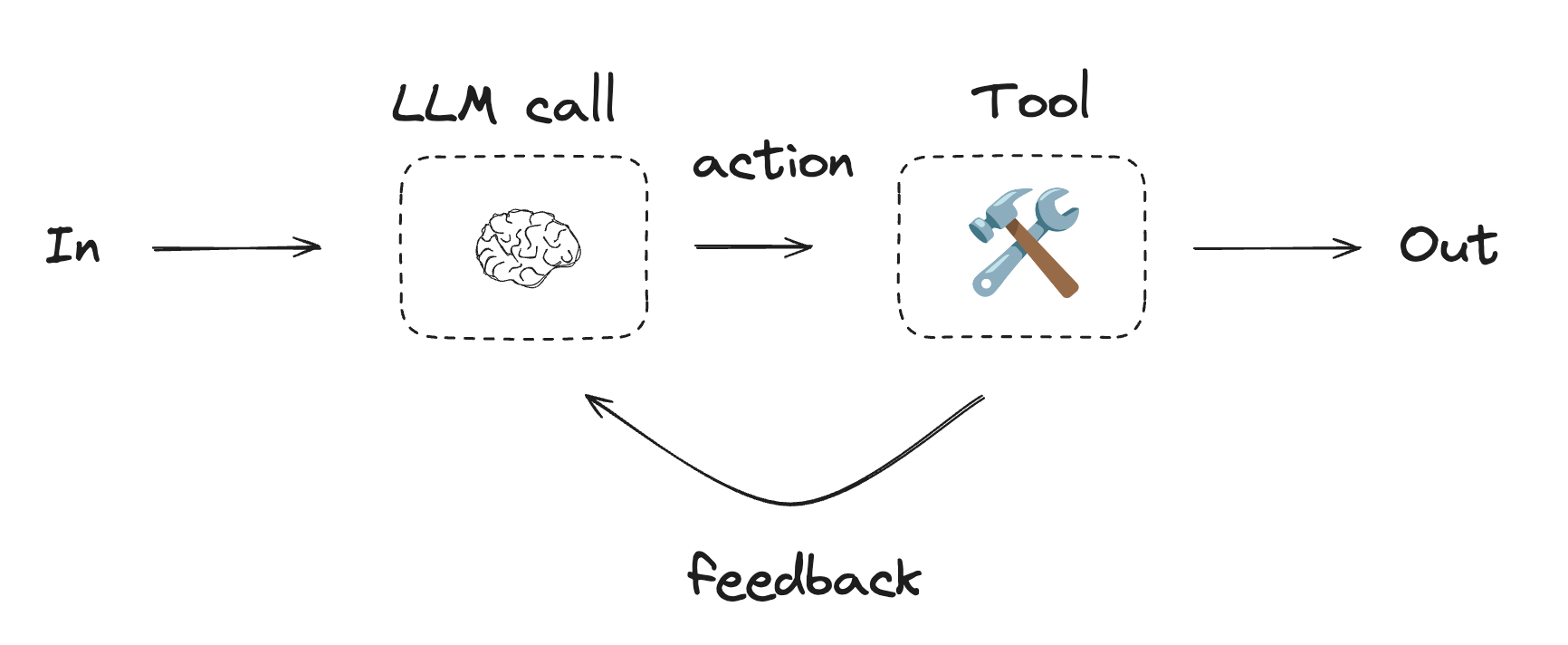
使用工具
复制
向 AI 提问
from langchain.tools import tool
# Define tools
@tool
def multiply(a: int, b: int) -> int:
"""Multiply `a` and `b`.
Args:
a: First int
b: Second int
"""
return a * b
@tool
def add(a: int, b: int) -> int:
"""Adds `a` and `b`.
Args:
a: First int
b: Second int
"""
return a + b
@tool
def divide(a: int, b: int) -> float:
"""Divide `a` and `b`.
Args:
a: First int
b: Second int
"""
return a / b
# Augment the LLM with tools
tools = [add, multiply, divide]
tools_by_name = {tool.name: tool for tool in tools}
llm_with_tools = llm.bind_tools(tools)
复制
向 AI 提问
from langgraph.graph import MessagesState
from langchain.messages import SystemMessage, HumanMessage, ToolMessage
# Nodes
def llm_call(state: MessagesState):
"""LLM decides whether to call a tool or not"""
return {
"messages": [
llm_with_tools.invoke(
[
SystemMessage(
content="You are a helpful assistant tasked with performing arithmetic on a set of inputs."
)
]
+ state["messages"]
)
]
}
def tool_node(state: dict):
"""Performs the tool call"""
result = []
for tool_call in state["messages"][-1].tool_calls:
tool = tools_by_name[tool_call["name"]]
observation = tool.invoke(tool_call["args"])
result.append(ToolMessage(content=observation, tool_call_id=tool_call["id"]))
return {"messages": result}
# Conditional edge function to route to the tool node or end based upon whether the LLM made a tool call
def should_continue(state: MessagesState) -> Literal["tool_node", END]:
"""Decide if we should continue the loop or stop based upon whether the LLM made a tool call"""
messages = state["messages"]
last_message = messages[-1]
# If the LLM makes a tool call, then perform an action
if last_message.tool_calls:
return "tool_node"
# Otherwise, we stop (reply to the user)
return END
# Build workflow
agent_builder = StateGraph(MessagesState)
# Add nodes
agent_builder.add_node("llm_call", llm_call)
agent_builder.add_node("tool_node", tool_node)
# Add edges to connect nodes
agent_builder.add_edge(START, "llm_call")
agent_builder.add_conditional_edges(
"llm_call",
should_continue,
["tool_node", END]
)
agent_builder.add_edge("tool_node", "llm_call")
# Compile the agent
agent = agent_builder.compile()
# Show the agent
display(Image(agent.get_graph(xray=True).draw_mermaid_png()))
# Invoke
messages = [HumanMessage(content="Add 3 and 4.")]
messages = agent.invoke({"messages": messages})
for m in messages["messages"]:
m.pretty_print()
以编程方式连接这些文档到 Claude、VSCode 等,通过 MCP 获取实时答案。

